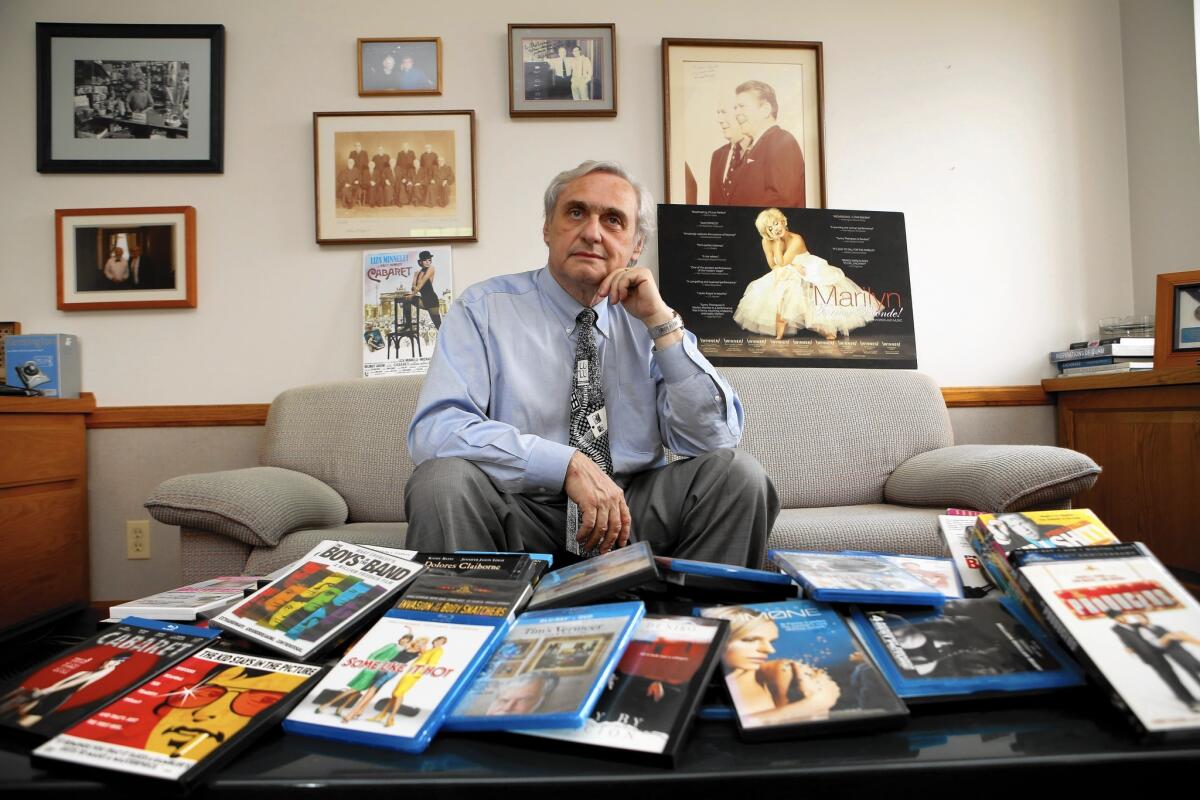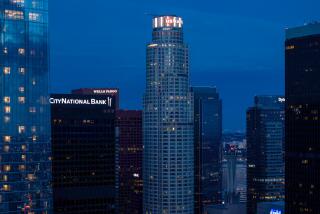Great Read: After court adjourns, 9th Circuit judgeâs movie nights are a hit

Judge Alex Kozinski in his chambers with a collection of movies. He started hosting movie nights years ago after learning that many of the law clerks in Pasadena had never seen â12 Angry Men,â the Henry Fonda classic about a holdout juror.
Reporting From San Francisco â Itâs movie night at the courthouse.
U.S. 9th Circuit Court of Appeals Judge Alex Kozinski, his identification and security tags hanging from his neck, greets dozens of people who have shown up early for a guided tour of the courtâs headquarters, an ornate columned building on the edge of San Franciscoâs seamy Tenderloin.
âThank you for coming,â the smiling judge says over and over again.
Later, the visitors line up in a court hallway to pick up pizza, salad and beer, wine or soft drinks. Then theyâll adjourn for the movie, a documentary called âTimâs Vermeer,â and a chat by the subject of the movie.
Kozinski, beer bottle in hand and sleeves rolled up, walks the line to say hello. A record crowd of more than 200 has showed up, and the judge is unsure why.
âPent-up demand?â he quips. âThe door prizes?â
Kozinski holds the event, known as KFF or Kozinskiâs Favorite Flicks, three or four times a year, usually at the San Francisco courthouse or at the 9th Circuitâs building in Pasadena, where Kozinski is based. A film buff who has his own Internet Movie Data Base page, Kozinski started movie night years ago after learning that many of the law clerks in Pasadena had never seen â12 Angry Men,â the Henry Fonda classic about a holdout juror.
The guest list has expanded since then: This nightâs crowd consists mostly of lawyers and their families, other judges, court clerks and federal employees. A woman from the federal public defenderâs office brought her teenage son.
âItâs fun,â said Lauren Klingman, 27, who was invited by her boyfriend, a clerk for a district judge. She said she had imagined judges to be serious, even dour. Kozinski surprised her. âHe is hilarious!â she said.
The movie is free, but Kozinski charges those who want dinner $10 for food and drink. If the pizza money doesnât cover the cost, Kozinski says, he spends his own money.
âWe should be viewed as being part of the community,â the judge said. âWe have these glorious facilities, and I want to bring the public in and show that this is a place where they are welcome.â
::
Kozinski, 64, speaks with an accent from his native Romania. He moved with his family to California when he was 17. His parents, Holocaust survivors, owned a grocery store in Hollywood across the street from ABC Studios. As a young man, Kozinski appeared on âThe Dating Game,â where he was bachelor No. 2. He won the date, but the woman stood him up.
He has appeared unpaid as himself in several documentaries and as a judge in the movie âAtlas Shrugged: Part II.â His two favorite movies are âCabaretâ and âThe Man Who Would Be King.â
It was Kozinski who dubbed the court âthe Hollywood Circuit,â and some lawyers have accused it of being protective of the entertainment industry in copyright cases. Kozinski, though, has decided against the industry in major cases.
He is considered both an iconoclast and a populist, known for a quick wit and a penchant for writing stylish and provocative rulings. In one case, he wrote that lethal injection should be scrapped for the firing squad, though he thought the guillotine the best method. He ended one ruling with the words: âThe parties are advised to chill.â
Kozinski is a conservative with a strong libertarian streak. He was only 35 when President Reagan appointed him to the 9th Circuit. As chief judge, a rotating post he held until December, he worked to make the court more accessible to the public. Every hearing is now videotaped and can be watched on the Internet.
Though more tech-savvy than most judges, Kozinski learned his limits several years ago when The Times reported that his familyâs home server, which he thought was private, could be seen by any snoop sophisticated in computers. One folder contained sexually explicit photos and videos with raunchy humor. He said they had been emailed to him over the years.
Kozinski asked that he be formally investigated. A panel of federal judges from another circuit admonished him, saying the folder had been made public because of an improper security configuration and the judgeâs âcarelessness.â
Some Kozinski critics have questioned using public courthouses for movie nights, but legal ethicists point out that federal courthouses are open to all sorts of community affairs.
New York University law professor Stephen Gillers said such gatherings give the public and the bar a much-needed glimpse of judges in an informal setting and keep the judiciary in tune with the people it serves.
âI think itâs actually good the community gets to visit the courthouse,â Gillers said. âAnd itâs of real value that judges have a sense of the pulse of the community.â
Stanford University law professor Deborah L. Rhode, another legal ethicist, and UC Irvine Law School Dean Erwin Chemerinsky, echoed that view.
Kozinskiâs love of film is well known around the 9th Circuit. Judge Stephen Reinhardt, a Carter appointee, said more court staff members than judges attend the movie nights. Some of the âstuffierâ judges might not approve, Reinhardt said, but the nights âmake life a little lighter for a lot of people.â
Kozinski calls his movie nights a âlabor of love.â He shops at Costco with Donna Salter, his administrative assistant of three decades, and some law clerks. Salter makes a chopped salad that gets rave reviews and that visitors discuss while waiting in line. Her recipe: spring mix, spinach, arugula, pecans, dried cranberries, mandarin oranges, edamame, cherry tomatoes and crisp chow mein noodles dressed with a balsamic vinaigrette.
âItâs a lot of work, but itâs fun,â Salter said. When the movies are shown in Pasadena, âmy mother, who is 93, always comes.â
Guests have included U.S. Supreme Court Justice Stephen G. Breyer, who came with his brother, a judge in San Francisco. Kozinski said Breyer, a fan of silent film, later hosted movie nights for his clerks.
Kozinski usually invites speakers â directors, producers, writers, actors or studio chiefs â to address the audience after the film. When he showed âThank You for Smoking,â Christopher Buckley, who wrote the novel it was based on, came. When Kozinski screened âThe Sessions,â a true story about a disabled man who hires a professional sex surrogate, the surrogate spoke. Peter Fonda came to a screening of âEasy Rider,â Michael York to âCabaretâ and Jeremy Ray Valdez to âLa Mission.â
Some speakers have connections to people who work for the court. Kozinski doesnât pay them, though he said he has had to help defray travel costs out of his pocket in a few cases.
During the 9th Circuitâs annual conference last year, Kozinski and another judge interviewed Clint Eastwood and showed his film âGran Torino.â It deals with immigrants, and the 9th Circuit decides immigration cases. A panel discussion with Eastwood can be found on the 9th Circuit site.
âIt is exceedingly important for us not to be viewed as aloof and divorced from life,â Kozinski said. âWe are not in a different world. You canât do law if you donât understand life.â
The courthouse, he said, is ânot a palace. This is a house of justice, and people should not be afraid to approach it.â
::
The tour through the San Francisco courthouse, a National Historic Landmark, takes visitors into private passages the judges use and into the office of Supreme Court Justice Anthony M. Kennedy, the high courtâs point man for the 9th Circuit.
The room has polished redwood walls, a high and shiny coffered ceiling, a massive marble fireplace and thick carpeting that absorbs sound. Scrolled around the base of the ceiling are the words: âHear one side, you will be in the dark. Hear both sides and all will be clear.â
Lothar Determann, who teaches law at UC Berkeley, rambled through the rooms with his parents, visiting from Germany. Lawyer Michael Shambrook said he landed on the invitation list after meeting Kozinski at a memorial service.
âKozinski is an unusual fellow,â Shambrook said. âBecause he is an unusual fellow, he does unusual things.â
The crowd is so large on this night that visitors spill into two overflow rooms to watch the movie. Little paper baskets of Halloween-size candy sit on the chairs.
Kozinski introduces the movie and mentions the names of the judges and groups in attendance. One group is from the California Appellate Project, which defends death row inmates. Another is from the Electronic Frontier Foundation, a nonprofit that advocates for Internet freedom.
Kozinski says he chose âTimâs Vermeerâ after seeing it with his wife at a theater. It is about the intersection of art and technology, the efforts of an inventor to use technology to paint Johannes Vermeerâs masterpieces.
Tim Jenison, the inventor and hobbyist, believes that the 17th century Dutch artist used mirrors and optics to achieve the photographic quality of his masterpieces, which include the famous âGirl With a Pearl Earring.â
In between the audienceâs questions for Jenison, Kozinski draws tickets and reads off the numbers for the door prizes: handmade movie posters that line the walls.
When a winner raises a hand, Kozinski says: âOK. Go grab one off the wall.â
Movie night ended at about 9:30 p.m. At 9 a.m. the next day, Kozinski, in black robe this time, was back on the bench.
Twitter: @mauradolan
More to Read
Sign up for Essential California
The most important California stories and recommendations in your inbox every morning.
You may occasionally receive promotional content from the Los Angeles Times.










